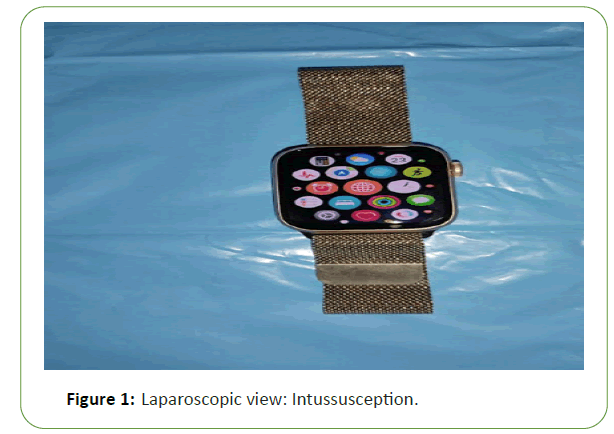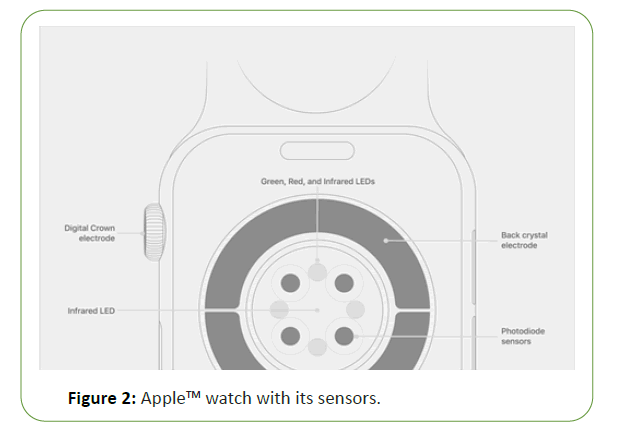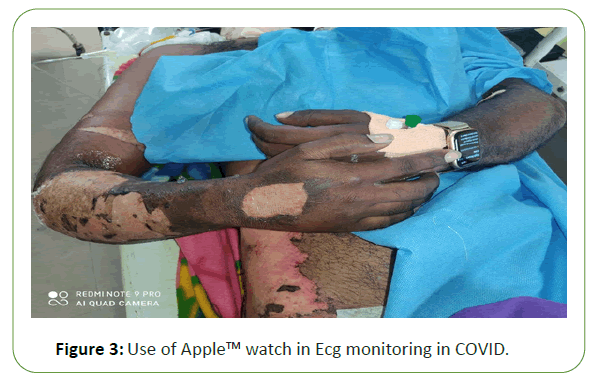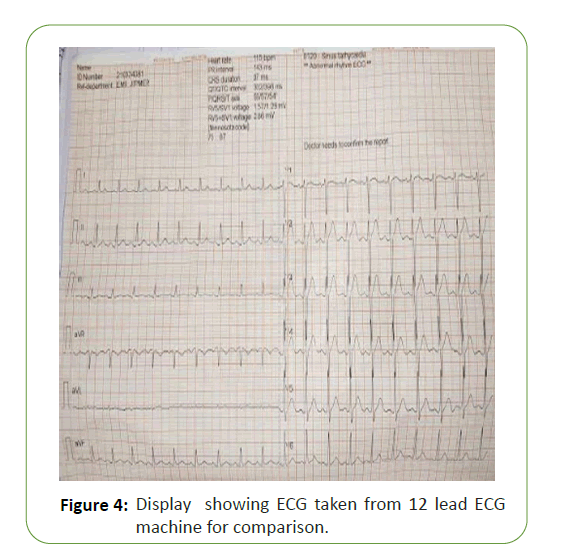ISSN : 2393-8854
Global Journal of Research and Review
Role of AppleTM Smart Watch in Casualty Management
Ravi Kumar Chittoria1*, Neljo Thomas1, Padmalakshmi Bharathi Mohan1, Shijina Koliyath1, Imran Pathan1,Sowmiya Velusamy2 and Manik Maharajan2
1 Department of Plastic Surgery, Jawaharlal Institute of Postgraduate Medical Education and Research, Pondicherry, India
2 Department of General Surgery, Jawaharlal Institute of Postgraduate Medical Education and Research, Pondicherry, India
- *Corresponding Author:
- Ravi Kumar Chittoria
Department of Plastic Surgery,
Jawaharlal Institute of Postgraduate Medical Education and Research,
Pondicherry,
India,
E-mail: drchittoria@yahoo.com
Received Date: April 19, 2021; Accepted Date: May 3, 2021;Published Date: May 10, 2021
Citation: Chittoria RK, Thomas N, Mohan PB, Koliyath S, Pathan I, et al. (2021) Role of AppleTM Smart Watch in Casualty Managemenft. Glob J Res Rev Vol.8 No.5: 82.
Abstract
Healthcare forms a novel field of technological development. Smart watches and smart bands which are in widespread use help in monitoring the health status of the wearer and have found many uses including monitoring of pulse rate, oxygen levels, number of footsteps, calorie calculator. New series Apple TMsmart watches can generate, record, and interpret ECG within seconds in an easier and reliable method. Hence it has the potential to transform healthcare.
Keywords
Apple TM; Electrical injury; Arrhythmias; ECG; Photo plethysmography
Introduction
Technology helps us in delivering better health care in ways in which our grandfathers could only imagine. Right from tracking our calorie intake to maintaining a chart of the menstrual cycle, it plays an important role. Electric watches are portable and wearable devices that help us in keeping us up to date with the ever-moving pace of the world and also in maintaining our health. Sudden cardiac death is important of death and needs early diagnosis [1]. Smartwatches contain biometric sensors that can work as non-invasive monitoring technologies and help in monitoring patients remotely as well as close. They make use of photo plethysmography that allows for heart rate monitoring and ECG monitoring. Other Current generation smartwatches which have ECG monitoring are the AppleTM watch series from 4,5 and 6, Samsung galaxy watches active 2 and 3, Fitbit sense, Withings scan watch, Withings move ECG, amazfit smartwatch 2, etc.
Apple TMsmart watch series 4,5 and 6 can record heart rate, oxygen saturation and does ECG monitoring. Its ECG is similar to single lead ECG [2]. It provides information about heart rate and rhythm. It has been proven inits usage in the detection of atrial fibrillation with high sensitivity and specificity [3].
There is paucity in studies comparing usage of smartwatches in the monitoring of patients in a hospital set up in comparison to routine multi-parameter vitals monitor. AppleTM smartwatch as a medical device has not been proven for usage but its accuracy in measuring heart rate, oxygen saturation, and ECG recording can be utilized as a simple device in the monitoring of patients in the hospital casualty setup. Casualty patients make a large number of patients in hospitals who require close monitoring [4]. In this article, we attempt to describe the usage of the Apple TM smartwatch in the monitoring of casualty patients.
Materials and Methods
This is a prospective study conducted in the department of plastic surgery in a tertiary care center.
This study was conducted during February and March 2021. In this study, a total of 20 patients admitted in casualty were included. Informed written consent was taken from the patient’s attenders and doctors regarding publication and use of clinical photographs [5].
A smartwatch (Apple, series 6) was used to record the ECG of every casualty patient admitted, soon at the time of the first contact with the triage team even before taking 12 lead conventional ECG (Figures 1and 2).The smartwatch was tied around the hand of the patient. For taking ECG, the patient’s opposite hand index finger was kept over the crown of the watch for 30 seconds (Figure 3) The reading and interpretation of ECG were noted. It was being compared with the 12 lead ECGs taken afterward (Figure 4).
Doctors were asked to rate the experience of usage of the device on a scale of 1 to 5 rating, the higher the score the more the satisfaction level. Feedback was taken from doctors (Table 1). For doctors, the Experience was rated based on the experience of getting to learn a new tool, reliability compared to 12 lead ECGs, and ease of using the smartwatch.
| Ease of usage | Reliability | Will you recommend others this device | |
|---|---|---|---|
| Physician-1 | 4 | 4 | No |
| Physician-2 | 4 | 4 | Yes |
| Physician-3 | 5 | 4 | Yes |
| Physician-4 | 4 | 5 | Yes |
| Physician-5 | 4 | 4 | Yes |
| Physician-6 | 4 | 5 | No |
| Physician-7 | 3 | 4 | Yes |
| Physician-8 | 5 | 5 | Yes |
| Physician-9 | 3 | 4 | Yes |
| Physician-10 | 4 | 4 | Yes |
| Average | 4 | 4.3 | Yes= 8/10 |
Table 1: Physician and their experience on scale of 1 to 5 rating, the higher the score the more was the satisfaction level.
Results
A total of 10 doctors participated in the study and a total of 20 patients were included in the study. All doctors commented they found it easy to use, reliable, and had a good overall experience (4 or more rating). The ECG recording of 20 patients was compared to 12 lead ECGs and was found to have similar in 19/20 cases and in one case it was detected as sinus tachycardia in the smartwatch which was normal sinus rhythm in 12 lead ECGs. The sensitivity of the ECG recording was 95%. The reliability of the device had an average score of 4.3. 8 out of 10 doctors stated that they would recommend the use of this device in casualty (Table 2)
| Questionnaire | Rating 1 to 5 (1 being worst, 5 being best) |
|---|---|
| How easily were u able to record ECG using AppleTMTMi watch | |
| How much was the reliability of the device compared to routine 12 lead ECG | |
| Would you like to recommend other for usage of this device | YES/NO |
Suggestions, if any:-
Table 2: Feedback form of Questionnaire.
Discussion
Sudden cardiac death (SCD) is death due to any cardiovascular cause that occurs within one hour of the onset of symptoms. A sudden cardiac arrest occurs when the heart stops beating or is not beating sufficiently to maintain perfusion and life. In patients younger than 35, the most common cause of sudden cardiac death is fatal arrhythmia, usually in the background of a structurally normal heart. 1 Long stay in emergency departments (EDs) is associated with higher patient mortality and worse outcomes.3 hence it is imperative to identify early cardiac abnormalities which require emergency management compared to other patients who need urgent management to save both the life of the patient and time in casualty.
Smartwatches are wrist-worn wearable devices that are general-purpose, networked computers with an array of sensors 5. Smartwatches with their biometric sensors including photoplethysmography have been exploited as self-monitoring devices that can monitor the distance walked, heart rate variability based on activity, and also estimated energy burned [6].
Apple TMsmartwatch series 6 is based on GSM/LTE technology. It consists of a 44 x 38 x 10.4 mm display, weighing around 47 grams and being waterproof. It has OS 7.0 expandable up to 7.3. with dual-core processors. It consists of Accelerometer, gyro meter, heart, always on altimeter, compass, Spo2, Vo2 maxis including photoplethysmography for heart rate monitoring. Apple TMsmartwatch consists of heart sensors based on photoplethysmography [6]. Apple TM smartwatches from series 4 can measure heart rate, oxygen saturation, and record ECG. It contains light-sensitive diodes, paired with green LED lights and infra-red rays. Using these light beams and sensors amount of blood flowing through one’s wrist can be estimated during each peripheral pulsation and heart rate is detected based on it. The peak-to-peak interval between pulsations can be interpreted as the cardiac R-R interval. This R-R interval interpretation is the algorithm behind the detection of rhythm abnormalities and arrhythmias detection. Built-in electrodes are present in the Crown and the back of the Apple TMWatch. When the finger is placed on the crown, it creates a closed circuit between the heart and both arms, capturing the electrical impulses. The results of ECG recording from the Apple TMwatch can be interpreted as Sinus rhythm, atrial fibrillation, High or low heart rate, and maybe inconclusive. If iPhone is integrated with smart-watch then the ECG waveform is classifications and associated symptoms if any can be stored in health app and can be used as pdf as well [7,8].
The ability of the Apple TMsmartwatch in ECG monitoring has been tested in multiple trials [9]. These studies have demonstrated 99.6% specificity concerning sinus rhythm and 98.3 % sensitivity in detecting atrial fibrillation. A study was done by Tison which showed that Smartwatches could passively detect atrial fibrillation when integrated with a deep neural network and could accurately discriminate atrial fibrillation from sinus rhythm with more than 98% sensitivity and 90.2 % specificity compared with the 12 lead ECG.
Even though the Apple TM smartwatch has multiple applications, it is not free of limitations [10]. Its high cost is one of the major limitations in its usage. The Apple TM watch which was being used for the study cost around 77,900 in Indian rupees (ranges from 39,000 up to 80,000). Apart from it, there are problems with measurement errors as well. The ECG recording can be inconclusive in case of condition as follows. (1) in case the patient has a pacemaker or implantable cardioverter-defibrillator. (2) The recordings may show signs of other arrhythmias or heart conditions that the app is not designed to recognize. Also, it can show poor recordings in case of the presence of water and sweat wrist. Measurement by the watch is also not possible or is inaccurate when the patient is ambulating; hence it is not useful for small children or in uncooperative patients. It is not suitable to detect cardiac arrhythmia other than atrial fibrillation.
Conclusion
Apple TM watch can be a potential health care device in easy and precise detection of rhythm changes in electrical burns patients. It can work as a screening device to detect patients who need emergency treatment. They help to reduce the burden on health care workers through their easy accessibility and interpretation of data. But since it is a small study, a definite conclusion cannot be made. Multiple large randomized control trials are required to confirm the efficacy of these devices and to prove their application in health care.
Authors’ Contributions
All authors made contributions to the article.
Support and Sponsorship
One of the authors has Apple TM smart watch which was used for this study purchase.
References
- Yow AG, Rajasurya V, Sharma S (2021) Sudden Cardiac Death, StatPearls Publishin, Florida, USA.
- Lu TC, Fu CM, Ma MH, Fang CC, Turner AM (2016) Healthcare Applications of Smart Watches. A Systematic Review. Appl Clin Inform 7(3): 850-869.
- Gruber J , Hoe TP , Stoye G (2018) . Saving lives by tying hands: the unexpected effects of constraining health care providers. NBER working paper No. 24445.
- Boggild H, , Freund L, and Bagger JP (1995) Persistent atrial fibrillation following electrical injury. Occup Med 45(1): 49-50.
- Rawassizadeh R, Price BA, and Petre M (2014) Wearables: Has the age of smartwatches finally arrived?. Communications of the ACM 58(1): 45-47.
- Massoomi MR, Handberg EM (2019) Increasing and Evolving Role of Smart Devices in Modern Medicine. Eur Cardiol 14(3): 181-186.
- Apple Support. Taking an ECG with the ECG app on Apple Watch Series 4.November 18, 2019.
- Raja JM, Elsakr C, Roman S, Cave B, Pour-Ghaz I, et al. (2019) AppleTMTMWatch, Wearables, and Heart Rhythm: where do we stand?. Annals of transl Med 7(17) : 417.
- Khushhal A, Nicholas S, Evans W, Gleadall-Siddall DO, Page R et al. Validity and Reliability of the AppleTMTMWatch for Measuring Heart Rate During Exercise. Sports Medicine Int Open 1(6): E206-E211
- Tison GH, Sanchez JM, Ballinger B, Singh A, Olgin JE, et al. (2018) Passive detection of atrial fibrillation using a commercially available smartwatch. JAMA Cardiol 3(5):409-416.
Open Access Journals
- Aquaculture & Veterinary Science
- Chemistry & Chemical Sciences
- Clinical Sciences
- Engineering
- General Science
- Genetics & Molecular Biology
- Health Care & Nursing
- Immunology & Microbiology
- Materials Science
- Mathematics & Physics
- Medical Sciences
- Neurology & Psychiatry
- Oncology & Cancer Science
- Pharmaceutical Sciences




